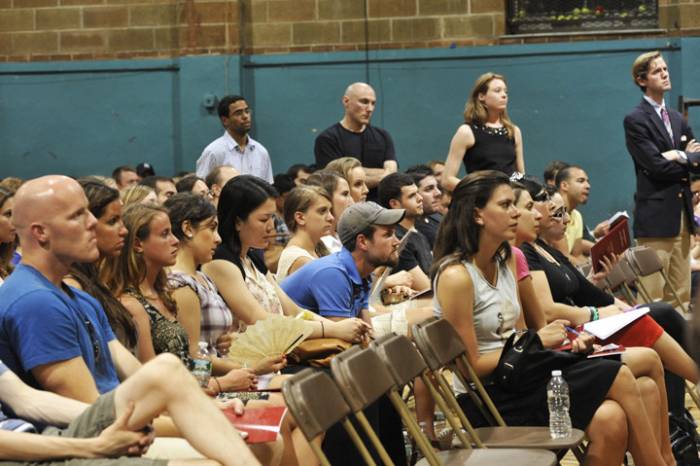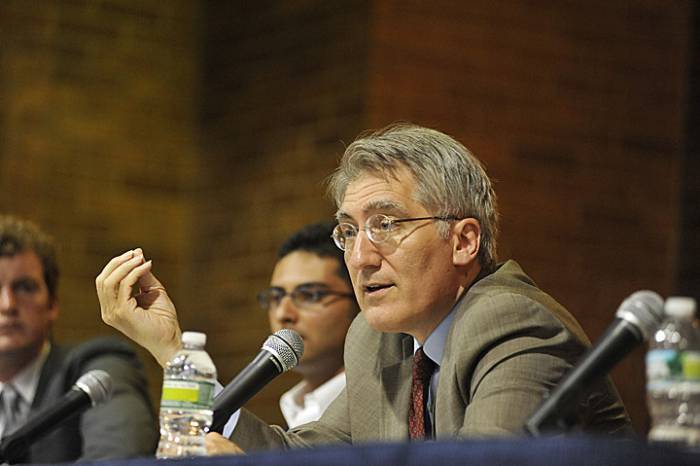As the issue of same-sex marriage was being debated in New York state, Catholic New York covered the story from many angles in a raft of news stories, columns, editorials and advertisements.
If the letters and e-mails we’ve received leading up to and since the state Senate’s misguided vote last month sanctioning same-sex marriage are any indication, the issue is not going away anytime soon.
Like millions of other New Yorkers, my wife, Lynn, and I have a personal stake in what the state’s laws have to say about marriage. Until this past Sunday, our marriage of 21 years enjoyed unique standing in New York state. That is no longer the case, thanks to a redefinition of what the word marriage means in New York. The definition of marriage, according to our civil law, now includes other relationships not at all like the bond shared by my wife and me.

Photo by Maria R. Bastone
MARRIAGE-MINDED—Large crowd of young adults listens to panel presentation on “What Is Marriage?” led by Princeton professor Robert George.
|

Photo by Maria R. Bastone
INFORMED VIEW—Princeton University professor Robert George makes a point during panel discussion on marriage in the Youth Center at the Basilica of St. Patrick's Old Cathedral on July 19.
|
Frankly, that’s one reason I decided to attend an evening panel presentation titled “What Is Marriage?” that was offered July 19 in the Youth Center of the Basilica of St. Patrick’s Old Cathedral in Manhattan. The event was organized by the archdiocese’s Young Adult Outreach under the leadership of its director, Patrick Langrell. He also served as moderator of the discussion, which included an extensive question-and-answer period with audience members.
The lead panelist, Robert George, the McCormick Professor of Jurisprudence at Princeton University, is regarded as one of the foremost Christian scholars in the United States. Joining him on the panel were Sherif Girgis, a doctoral candidate in philosophy at Princeton University, and Ryan Anderson, a doctoral candidate in political science at the University of Notre Dame.
“What Is Marriage?” also happens to be the title of a well-received article that the trio co-authored in the Winter 2010 edition of the Harvard Journal of Law and Public Policy. If you can locate a copy of the nearly 40-page article, it will be well worth your time. The panelists each delivered a brief overview comparing what they termed the “conjugal” view of marriage (traditional one man and one woman unions) with that of the “revisionist” view (same-sex partnerships). In answering the question of what marriage actually is, Girgis said three general features conceded by supporters of both the conjugal and revisionist views are comprehensiveness, a special link to children and norms of permanence and exclusivity. In each case, the conjugal view makes the more “robust” argument, he said.
Marriage is a comprehensive union between two people at every level of their being, including sexual activity and bodily union, expressions that are most naturally and completely fulfilled in the marital act between a man and a woman, Girgis said. The relationship of marriage itself is ordered to and embodied by the bearing and rearing of children, he said. There are norms that apply to marriage that don’t apply to other relationships, including friendships. If you want a real marriage, you have to pledge permanence and exclusivity.
The panelists did not rely on religious arguments to bolster their case, though they noted that religion should not be excluded from the marriage debate, either. Instead, Anderson said that his argument is focused on nature, reason and common humanity.
He went on to say that when it comes to promoting the case for the conjugal view of marriage, its supporters “should not be playing defense.” That’s easier said than done in a popular culture and media landscape where those who make a case for marriage in its time-honored, traditional sense are often branded as bigots, homophobes and haters, he explained.
Turning the tables on those who express support for same-sex marriage, Anderson offered these questions: What principle of reason would limit such partnerships to two people? Or to a relationship that is sexually exclusive? Or permanent?
“Our argument,” Anderson concluded, “is that once you eliminate sexual complementarity in the bodily union that is uniquely formed between a man and a woman then you no longer have any rational basis for including those three norms.”
That gave me a lot to think about. So did George’s assertion that each generation of Americans is called “to live in accordance with norms that enable a democratic republican government to survive.”
As Catholics, our understanding of marriage as a sacrament is a great gift as well as a consolation at this time of tempest and turmoil in our state’s political life. As Americans, and as New Yorkers, we should continue to make our voices heard to civilly and religiously defend what we hold dear, for ourselves and for our nation’s future.